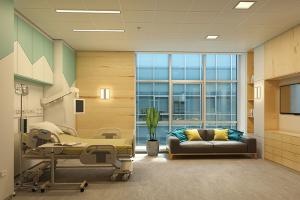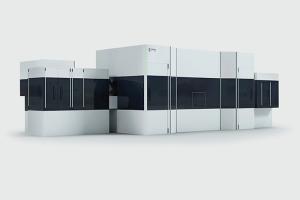Advances in health care 'edutainment' systems
Historically, TV and large-format displays in hospitals were utilized mainly for entertainment purposes. But they are now moving toward a more integrated platform that allows patients to select among entertainment, care updates and patient education information.
Providers now see a dramatic move to engage patients in their care through risk screenings, education and communication tools. Many are working with hospitals to optimize their education strategy and extending it beyond the four walls of the facility, both pre- and post-stay.
You may also like |
| Technology and health facility design |
| Transitioning from analog to digital television systems |
| Technology drives patient involvement |
|
|
As facilities professionals realize that the TV or tablet device can serve as a patient's digital personal assistant, they are finding more ways to utilize these systems as engagement tools. “Since the dawn of interactive patient TV systems, they have provided entertainment such as movies and targeted patient education videos as well as displaying hospital information and offering survey tools,” says Scott King, chief technology officer, eVideon, Grand Rapids, Mich.
New systems are being interfaced with hospitals’ food management software — delivering bidirectional interactivity with electronic health records (EHRs), integrating with real-time locating systems and assessing patients' comprehension of their learning plans, King adds. They also can interface with the hospital pharmacy.
“If hospitals are interested in using an entertainment system to engage patients, we provide video versions of our interactive, multimedia programs,” says Greg Blew, chief creative officer and vice president of product management, Emmi, Chicago. “As health care becomes more consumer-centric, there is a need to create more meaningful relationships with people outside the care setting.”
Emmi is beginning to roll out new capabilities that can use data they collect, such as patient-reported outcomes, to deliver more dynamic, personalized and interactive patient engagement programs. “We will be able to integrate these new capabilities into interactive entertainment systems to provide a seamless and consistent experience before, during and after a hospital stay,” he adds.
Going mobile
More patient education and entertainment systems are moving onto tablets and smartphones, and play a complementary role in the interactive patient experience. Tablets and mobile devices provide a supplemental means to search for relevant content and provide a virtual keyboard for input. But the in-room TV experience is still primary.
“TV is still the dominant and preferred delivery method for interactive patient systems, but tablets can be used in conjunction with the TV to offer a more engaging experience,” says Frank Forte, chief business development officer, TVR Communications LLC, Lake Success, N.Y., which produces the pCare Interactive Patient Systems. “One example of a pCare Interactive Patient Systems installation that uses TVs as the primary source and iPads as a second screen experience is pCare’s partnership with Children’s Hospital of Pittsburgh,” Forte notes. “Pediatric patients are able to use hospital-provided iPads to interact with and control pCare. This also is important to family members who would otherwise be competing for TV access with their child.”
TeleHealth Services, Raleigh, N.C., recently introduced TigrConnect, a mobile offering that provides patient education to ambulatory settings, medical office buildings and other key care touch points in areas that do not typically have bedside TVs. It provides the same look and feel that patients have become accustomed to during their inpatient stay, according to Matt Barker, vice president of marketing.
In addition, TeleHealth Services has developed Tigr@Home, which adds an additional layer to this service. “It provides push messaging of key patient education content to mobile devices and the patient portal. As a result, patients and caregivers have access to hospital-approved information at the optimal teachable moment, while hospitals have the ability to guide and track patients through their unique care continuums,” Barker notes.
SONIFI Health, Sioux Falls, S.D., offers a tablet solution that hospitals can leverage to work independently or with their interactive TV solution. This gives patients options as to how they want to interact with the system based on preference and accessibility in areas where TVs aren’t supported; it also gives them a unified experience between each of the platforms. “To further enhance patient engagement, we recently unveiled our SoniCast powered by Google Chromecast, which allows patients to cast content from hundreds of apps via their mobile device,” says Bob Sullivan, SONIFI Health general manager. “This technology allows patients to connect their mobile device to the TV and stream their favorite apps without entering any personal information.”
To meet the needs of all patient populations, GetWellNetwork Inc., Bethesda, Md., can deliver content at the bedside TV, on a tablet in an emergency department or outpatient setting, or on a smartphone inside or outside of a health care facility. “We continue to make health care information accessible in more locations by more individuals — finding ways to leverage the devices that administrators, clinicians, patients and families have to streamline the exchange of information,” says Michael O’Neil, founder and CEO.
Custom programming
For the inpatient setting, GetWellNetwork offers a system that incorporates everything from video conferencing for virtual care, to room temperature controls for patients, to decision support about post-acute care providers. “For the outpatient setting, we introduced GetWellNetwork Ambulatory to drive continuity in the patient’s experience and care plan before and after an acute care episode,” O’Neil says.
Patients can enter goals and questions, access educational content and provide feedback about their doctors' offices or clinic visits. Physicians can then review this information on a dashboard to personalize the care they deliver, making the encounter more satisfying for the patient and more productive for the provider.
Vendors of these education and entertainment systems say they are focused on building products that can improve a hospital’s operation. For instance, TVR Communications’ pCare real-time feedback capability was implemented at Northwell Health’s Peconic Bay Medical Center, Riverhead, N.Y. This feature allows staff to respond quickly to such patient concerns as noise level or room cleanliness. Patients provide feedback to five or fewer “yes" or "no” questions by pressing numbers on the TV remote or touchscreen. A message is then sent to care team members, which allows them to quickly correct the situation.
With the focus on entertainment, LG Electronics USA, Lincolnshire, Ill., offers the Pro:Centric Smart IPTV platform. The system includes a built-in program guide, which offers patients a TV channel guide similar to what they may have at home, enabling viewing and selection of their favorite programs, all from the comfort of their beds.
“Pro:Centric can be customized to deliver on-screen information such as weather forecasts, facilities procedures and appointment reminders, as well as patient benefits such as medicine reminders, which increases patient compliance across all categories. The platform also can broadcast emergency notifications, ensuring quick communication to the entire facility,” says Tim Wright, director of health care sales.
EHR integration
The latest patient education and entertainment systems can be integrated with EHRs to deliver or record information for each patient. EHR integration is a key component of many systems, according to Barker. “The SmarTigr platform can assess the patient’s activation level and use that information to customize his or her experience,” he says. “In addition, demographic data can be used to customize the education plan in a different language, or deliver directive information.”
Based on the diagnosis or procedure, the hospital can automate curricula to deliver throughout the inpatient stay. “Amenities such as room service-style meal ordering can provide customized meal options based on diagnosis. Finally, that same education plan can follow the patient home, while giving hospitals the ability to document and record the session in the EHR,” Barker adds.
eVideon systems can integrate with EHRs such as Epic, and the Veterans Health Information Systems and Technology Architecture and its Computerized Patient Record System. They streamline the documentation of patient education videos and reduce the time that nurses spend on selecting and delivering education. Educational content can be automatically assigned on admission for general or department-specific hospital videos. Educational content also can be assigned to address individual patient learning needs.
TVR Communications’ pCare can fully integrate with a hospital’s EHR system. Educational content is mapped electronically to elements of the patient plan of care, which includes diagnosis, procedures and medications. Education videos and literature are automatically delivered to patients or assigned to them by physician orders or nursing plan of care. Patient viewing and comprehension feedback are automatically documented in the EHR.
Outbound service
Patient education and entertainment systems are designed to engage patients after they leave the hospital as well, providing post-treatment content remotely. SONIFI Health offers Continuum, which can be delivered via stand-alone portal or integrated with the hospital’s EHR portal. Hospital staff are able to provide post-discharge information to be viewed in the portal as well. This may include post-treatment or additional resources for the patient to watch at home.
For outbound patients with chronic conditions, clinicians can prescribe evidence-based Interactive Patient Care pathways through myGetWellNetwork. These pathways help patients to follow their specific care plans for 30, 60, 90 or 365 days, adapting to individual progress toward reaching health goals. Patients can update their health status and record milestones, and have notifications, care tips and reminders delivered to their devices to reinforce the routine of care management. This is especially helpful for populations with heart failure, diabetes, chronic obstructive pulmonary disease and pediatric asthma.
Patient education and entertainment systems also are designed to address the needs of off-site facilities. For example, the SONIFI Health interactive TV system can be delivered through coaxial cable or a facility’s existing intranet.
“The use of the existing infrastructure has hospitals leveraging their head-end installation to provide services to outlying care settings,” Sullivan explains. “In several instances, SONIFI Health can use the hospital’s fiber network to provide interactive services at another facility via the hospital servers. This eliminates the need for additional server space and additional hardware installation
at the clinic.”
Neal Lorenzi is a freelance writer based in Mundelein, Ill.
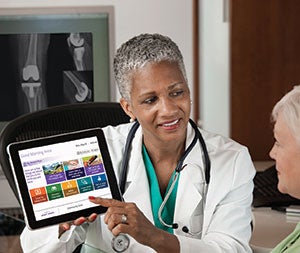
Total wellness
This system helps health care providers to engage, educate and empower patients in any setting. GetWellNetwork Inc.
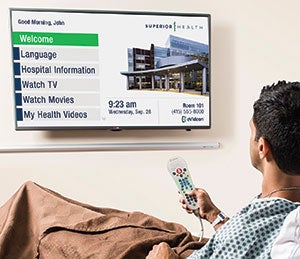
Easy interaction
This interactive patient care solution entertains, educates and engages patients and visitors, while streamlining workflows for hospital staff. eVideon

Near or far
This mobile application allows patients to utilize their mobile devices to access hospital services and the features that are delivered through the Interactive Patient Engagement System. SONIFI Health Inc.
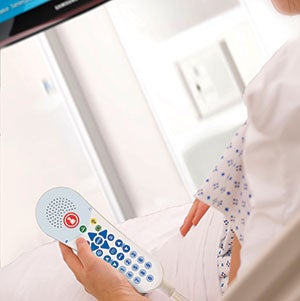
Targeted solution
The SmarTigr interactive patient engagement system puts patient-specific health information at patients’ fingertips. TeleHealth Services
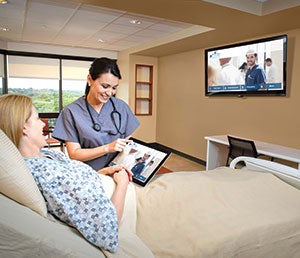
Screening options
The pCare Interactive Patient System combines television and mobile devices for an all-inclusive solution. TVR Communications LLC
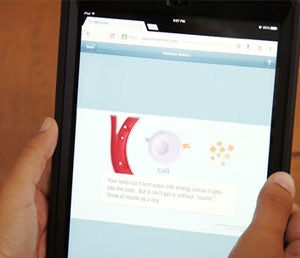
Teaching assistant
This online, interactive multimedia program with interactive voice response calls helps patients to better understand their diagnoses and care. Emmi Solutions LLC


